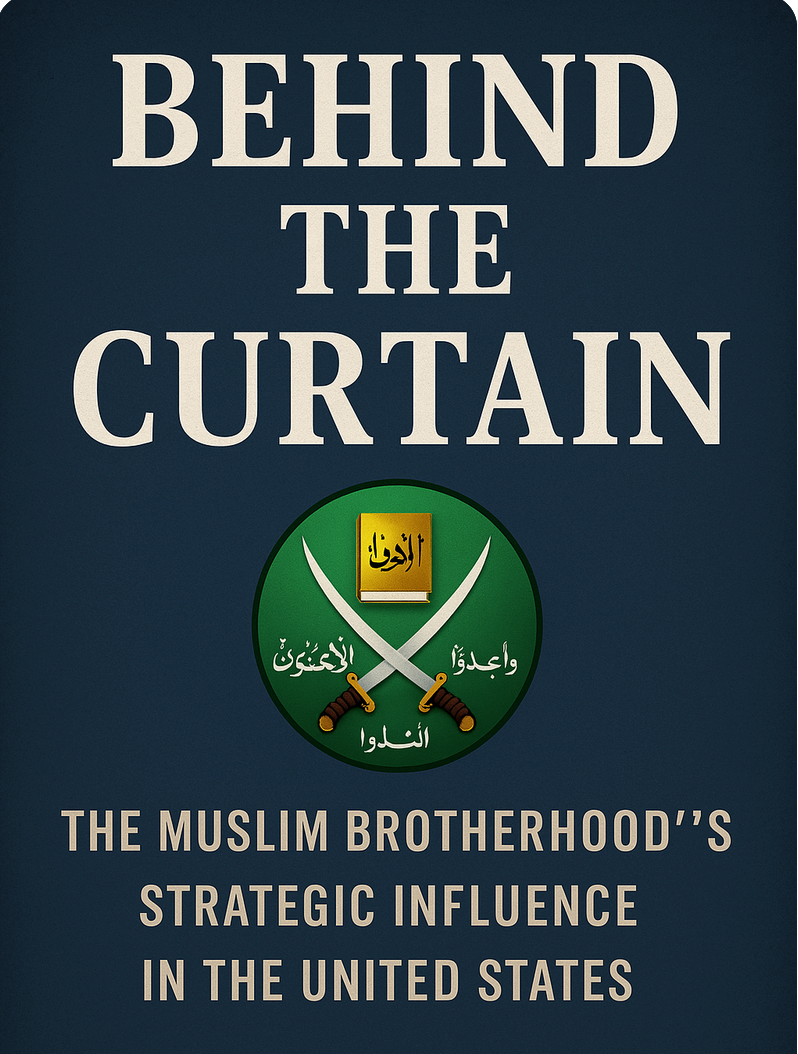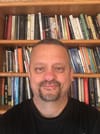

By Dr. Tim Orr
If someone asked you to name the most influential Muslim organization in the United States, would the Muslim Brotherhood even make the list?
For most Americans, the Brotherhood is vaguely understood as an “Egyptian thing”—a foreign political movement without formal presence here. But that impression is not only misleading—it’s dangerous. The truth is that the Muslim Brotherhood has become one of the most impactful ideological forces shaping Muslim institutions and narratives in the U.S., even though its fingerprints are often obscured. As someone who has spent decades engaged in interfaith ministry and as a researcher on Islamic antisemitism, I’ve seen firsthand how these networks operate beneath the radar.
That’s why the work of Lorenzo Vidino has been so eye-opening. A seasoned academic with deep experience in counterterrorism and ideological analysis, Vidino has devoted his career to studying the Brotherhood’s Western networks. His books, The New Muslim Brotherhood in the West (2010) and The Closed Circle (2020), as well as his recent lectures, offer a detailed roadmap for anyone seeking to understand how a tightly knit, ideologically driven network exerts disproportionate influence in a country like the United States—without ever being voted into office, or even naming itself publicly.
From Egypt to Indiana: How the Brotherhood Arrived in the U.S.
The Muslim Brotherhood was founded in 1928 by Egyptian schoolteacher Hassan al-Banna with a bold mission: to restore the Islamic world’s spiritual vitality and political power through a total revival of Islamic life. This wasn’t just about personal piety. Al-Banna envisioned Islam as a comprehensive system that governed personal, familial, social, economic, and political life. He says, “Islam is a faith and a ritual, a nation and a nationality, a religion and a state” (Vidino, 2010, p. 2).
When Brotherhood members began fleeing crackdowns in Egypt and Syria during the 1950s and 1960s, many landed in Europe and North America. What followed was not just immigration but strategic implantation. These early émigrés—mostly engineers, doctors, and scholars—brought with them a vision for shaping Muslim life in the West. They didn’t just want to live as Muslims in America—they wanted to shape what Islam in America would look like.
This is how organizations like the Muslim Students Association (MSA) and later the Islamic Society of North America (ISNA) emerged. Though these groups presented as non-political and civic, their founding members were steeped in Brotherhood ideology. They envisioned America’s growing Muslim population as fertile ground for a long-term project of re-Islamization—a mission that mirrored the Brotherhood’s approach in the Middle East, just contextualized for democratic societies (Vidino, 2010).
One of the Brotherhood’s most striking strategic decisions has been its quiet but intentional expansion into affluent suburban communities—and here in Indiana, the pattern is evident. In cities like Fishers, Carmel, and Avon, Brotherhood-influenced groups have helped establish prominent mosques, Islamic schools, and community centers that serve as places of worship and ideological and social hubs. These are not fringe outposts. These are polished, highly organized institutions embedded in upper-middle-class neighborhoods, often with multi-million-dollar facilities and programs designed to appeal to professionals, families, and youth alike.
In these settings, the Brotherhood’s hallmark strategy of cradle-to-grave engagement comes into view. These centers offer total community immersion from children’s Quran classes and scouting programs to high school leadership academies and adult marriage seminars. What might appear to be cultural assimilation on the surface often masks a deeper ideological project rooted in political Islam. Brotherhood-aligned leaders don’t call for confrontation with the West, but for Islamizing it from within, incrementally, through shaping values, civic involvement, and generational influence.
Moreover, the Brotherhood's presence in these suburban areas allows it to interface more directly with public school systems, city councils, and interfaith initiatives. Their representatives are often articulate, American-educated, and involved in civic life. Yet behind the outreach often lies a framework that sees the U.S. not as a home to be shared, but a territory to be ideologically engaged and, eventually, transformed.
As someone who lives near these communities and has personally visited these centers, I can attest that many people—Muslims and non-Muslims alike—are unaware of the underlying vision that guides their leadership. The friendliness and professionalism are genuine, but so is the long-game strategy. And it is precisely in places like Fishers, Carmel, and Avon—where American comfort meets religious community—that the Brotherhood has found fertile soil for quiet ideological expansion.
The Strategy of Incrementalism
The Muslim Brotherhood’s influence doesn’t come through violence or political takeover, at least not in the West. Instead, Vidino identifies what he calls a gradualist approach. The Brotherhood invests in patient institution-building, community organizing, and the cultivation of elite influence. It seeks to shape society from the bottom up, starting with the individual, then the family, then the local community, until Islamic norms are embedded into public life (Vidino, 2025).
This mirrors al-Banna’s famous pyramid of reform:
- Form the ideal Muslim individual
- Build the ideal Muslim family
- Create the ideal Muslim society
- Establish the Islamic state
- Revive the global caliphate
While some might dismiss this as abstract theorizing, the Brotherhood’s work in the U.S. has given tangible form to this vision. Vidino points to the creation of large, well-funded “mega mosques” that provide prayer services and a complete ecosystem of religious, social, and even political programming (Vidino, 2025). These centers often offer schooling, marriage services, youth programming, and political advocacy—all with an ideological undercurrent.
In my own experience, I’ve seen mosques near Brotherhood-linked institutions in Indiana operate with professional polish and strategic intent. These are not just religious spaces—they are platforms for cultural transformation.
Strategic Silence: Why No One Admits to Brotherhood Ties
What sets the Brotherhood apart from other Muslim groups is its strategic vision and its silence. One of Vidino’s most striking insights is that in the West, Brotherhood-linked individuals rarely admit their affiliation, even though it’s not illegal to be part of the Brotherhood in the U.S. This secrecy is not accidental—it’s embedded in the Brotherhood’s operational philosophy (Vidino, 2020).
This tactic of denial and ambiguity serves several purposes:
- Avoiding scrutiny from the media, law enforcement, or the public.
- Maintaining plausible deniability while influencing policy or interfaith circles.
- Avoiding internal dissent, especially from younger members who use secretive or manipulative tactics, might disillusion.
Vidino’s second book, The Closed Circle, is based on interviews with former Brotherhood members who left because of these concerns. Many were initially drawn to the Brotherhood’s vision of Islamic renewal, only to discover a rigid, cult-like atmosphere obsessed with secrecy, control, and long-term infiltration (Vidino, 2020).
I found this particularly compelling. When Vidino engaged former Islamists in private, many expressed a sense of moral exhaustion—not because they disagreed with Islam, but because they felt manipulated by a political machine disguised as a religious movement.
Disproportionate Influence in American Islam
One of Vidino’s most important contributions is the idea of “disproportionate influence.” Brotherhood-linked activists may be small in number, but they dominate the most visible, organized, and well-funded institutions in American Islam (Vidino, 2010).
This dominance plays out in several areas:
1. Media Representation
When mainstream media needs a “Muslim voice,” it often turns to CAIR, ISNA, or Muslim Public Affairs Council (MPAC)—groups with Brotherhood-linked leadership. These organizations are proactive in public relations and responsive to journalists, giving them a disproportionate say in defining what it means to be Muslim in America (Vidino, 2025).
2. Interfaith Dialogue
Many churches and synagogues that host “interfaith nights” unknowingly partner with groups that espouse a Brotherhood worldview behind the scenes. On the surface, the conversation is about coexistence. Underneath, it’s about positioning Islam as politically aggrieved and socially ascendant.
3. Political Advocacy
Groups like American Muslims for Palestine (AMP) or Students for Justice in Palestine (SJP) regularly advocate for radical policies—such as the elimination of the Jewish state—while cloaking their language in human rights rhetoric. Vidino shows how many of these organizations are either continuations or repackaged offshoots of Brotherhood-aligned networks that once supported Hamas directly (Vidino, 2010).
Antisemitism as a Strategic Tool
This leads us to one of the most troubling aspects of the Brotherhood’s influence: its theological and political antisemitism. While some American observers assume that Muslim-Jewish tensions are mostly about geopolitics, Vidino reveals that the Brotherhood’s antisemitism is deeply theological and rooted in conspiracy theories.
The Brotherhood draws not only from Quranic polemics but also from 20th-century European antisemitic texts. Brotherhood branches across the Arab world have actively promoted The Protocols of the Elders of Zion, a forgery created in Tsarist Russia to incite hatred against Jews (Vidino, 2025).
In the U.S., this manifests in the relentless centrality of Palestine as the core issue around which Muslims are mobilized, regardless of their ethnic or national origin. Vidino notes that Muslims from South Asia, who have no historical connection to Palestine, have nonetheless been drawn into a worldview that sees Jews and Zionism as the ultimate source of Muslim suffering (Vidino, 2025). That shift didn’t happen naturally—it was engineered through decades of Brotherhood indoctrination.
A Crisis of Representation
So what’s the impact of all this?
The Brotherhood has successfully positioned itself as the default representative of American Muslims, while promoting an exclusivist, politically charged, and often anti-Western version of Islam. This has created a crisis of representation for the broader Muslim community.
Most American Muslims are not Islamists. They’re not political activists. They’re not trying to create an Islamic state. Many are deeply patriotic, moderate in belief, and open to interreligious friendship. But their voices are often drowned out by a small group of activists with an outsized megaphone.
Vidino’s work is a wake-up call—not just to policymakers and scholars, but to pastors, rabbis, and imams who care about the integrity of religious life and the future of pluralism in America.
Conclusion: Discerning Engagement in an Age of Ideological Warfare
As an evangelical Christian engaged in cross-cultural ministry, I approach these issues with urgency and humility. We are called to love our Muslim neighbors, but that love requires truthfulness. Discerning the difference between the Muslim Brotherhood and the average Muslim American is not only a matter of political accuracy—it’s a matter of gospel integrity.
Vidino has given us the tools to understand the Brotherhood’s true nature: a global ideological movement, operating without a name, influencing without transparency, and speaking loudly without accountability. We must first understand the forces shaping the narrative to engage Muslims with honesty, wisdom, and compassion. And we must be willing to speak plainly—even when the truths we uncover are uncomfortable.
References
Vidino, L. (2010). The new Muslim Brotherhood in the West. Columbia University Press.
Vidino, L. (2020). The closed circle: Joining and leaving the Muslim Brotherhood in the West. Columbia University Press.
Vidino, L. (2025, March). Understanding the Muslim Brotherhood in the West [Lecture transcript]. Institute for the Study of Global Antisemitism and Policy.
Who is Dr. Tim Orr?
Tim serves full-time with Crescent Project as the assistant director of the internship program and area coordinator, where he is also deeply involved in outreach across the UK. A scholar of Islam, Evangelical minister, conference speaker, and interfaith consultant, Tim brings over 30 years of experience in cross-cultural ministry. He holds six academic degrees, including a Doctor of Ministry from Liberty University and a Master’s in Islamic Studies from the Islamic College in London.
In addition to his ministry work, Tim is a research associate with the Congregations and Polarization Project at the Center for the Study of Religion and American Culture at Indiana University Indianapolis. His research interests include Islamic antisemitism, American Evangelicalism, and Islamic feminism. He has spoken at leading universities and mosques throughout the UK—including Oxford University, Imperial College London, and the University of Tehran—and has published widely in peer-reviewed Islamic academic journals. Tim is also the author of four books.
